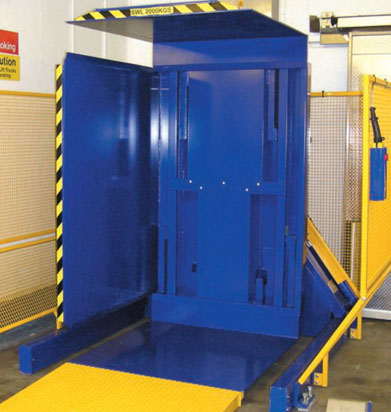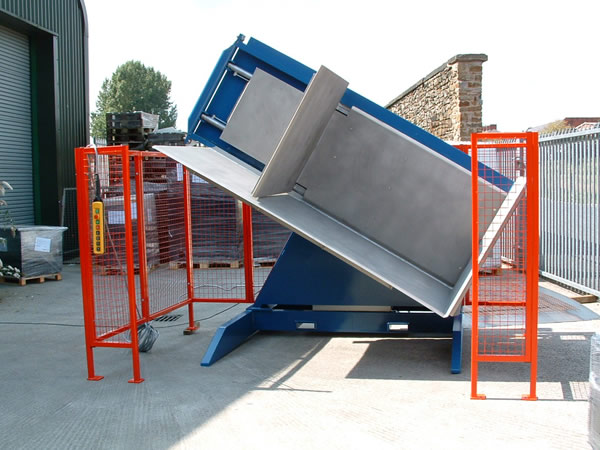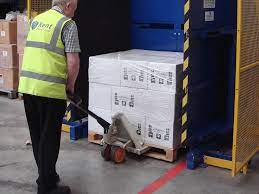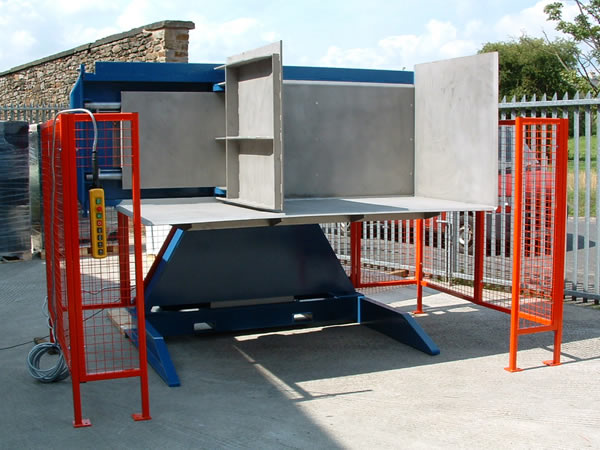Pallet Inverter Safety Tips for Indonesia Plants Facing Worker Safety Amid Rising Logistics Demand
In my years in the packing machine industry, I've seen a common pattern repeat itself across the globe. Whether in the bustling factories of Indonesia or the large-scale steel mills of Mexico, rising demand creates immense pressure. This pressure forces plants to increase speed and output. But often, this comes at a dangerous cost: worker safety gets pushed to the side. A pallet inverter is a powerful tool for efficiency, but when safety is an afterthought, it can become a serious liability. An accident doesn't just represent a human tragedy; it's a catastrophic failure in operations that brings production to a halt and can damage a company's reputation and bottom line.
The most effective way to ensure pallet inverter safety, especially in high-pressure environments like Indonesia's growing logistics sector, is through a dedicated, multi-layered strategy. This involves three core actions: first, conducting a thorough risk assessment before the machine is even used; second, implementing comprehensive and ongoing operator training; and third, adhering to a strict, non-negotiable preventive maintenance schedule. Together, these steps create a robust safety net that protects your workers, your equipment, and your production targets.

These principles might sound straightforward. But as someone who has walked through hundreds of factories, from my early days as an engineer to now owning my own, I've seen where good intentions fail. The difference between a safe, efficient plant and a hazardous one is always in the execution. The details matter. I want to share some practical lessons I've learned, not from a textbook, but from real-world situations. Let's break down each of these critical areas. This is the knowledge I wish I had when I was starting out, and it's the foundation for building a truly safe and productive operation.
How Can a Robust Risk Assessment Prevent Pallet Inverter Accidents?
You have decided to invest in a new pallet inverter to improve your plant's efficiency. It's a smart move. But the moment it arrives on your floor, before it moves its first pallet, you face a critical choice. You can assume its factory-installed safety features are enough, or you can conduct your own risk assessment. Many managers, under pressure to get the machine running, skip this step. They see it as just more paperwork delaying production.
This is a dangerous and costly assumption. An accident happens in an instant. A worker gets too close, and a piece of loose clothing gets snagged. A load is unbalanced and shifts unexpectedly during rotation. When an incident occurs, the first question investigators will ask is, "Where is your risk assessment for this machine and this process?" The lack of a proper answer can have devastating legal and financial outcomes. It reveals a gap in your safety protocol.
A comprehensive risk assessment is not a bureaucratic hurdle. It is a strategic blueprint for creating a safe operating environment. It allows you to look at the machine, the environment it's in, and the people who will use it, and to identify potential dangers before they can cause harm. It’s the first and most important step in protecting your people and ensuring your new equipment delivers on its promise of efficiency without compromising safety.
A robust risk assessment prevents pallet inverter accidents by methodically identifying every potential hazard linked to the machine, its placement, and its interaction with your team. This process requires you to evaluate both the likelihood and the potential severity of each risk. Based on this analysis, you then implement specific control measures—like physical guards, safety sensors, and clear operational procedures—to eliminate or reduce these dangers to an acceptable level.

Deconstructing the Risk
A truly effective risk assessment for a pallet inverter must be holistic. I've seen too many that are just a simple checklist copied from the manufacturer's manual. That's not enough. You have to analyze the machine in your specific context. From my experience, I break it down into three critical areas.
Machine, Environment, and People
First, you must analyze the machine-specific hazards. This goes beyond the obvious. You need to consider the clamping force, the speed of rotation, and the potential failure points in the hydraulic or electrical systems. I once visited a client's facility where they handled heavy steel coils. The pallet inverter was top-of-the-line, but the emergency stop button was on the main control panel, about two meters away from the loading area. During our risk assessment, we asked a simple question: "If an operator's glove gets caught while positioning a load, can they reach the E-stop?" The answer was no. We recommended installing a secondary E-stop button right at the loading station. It was a simple, low-cost modification that addressed a serious potential hazard.
Second, you have to assess the environmental and process hazards. The machine doesn't operate in a vacuum. It's part of a larger workflow. For a leader like Javier Morales in a large steel mill, this is crucial. You have forklifts, cranes, and people moving around constantly. Your assessment must account for this traffic. Is the floor strong enough and perfectly level? Is there enough clearance around the machine for operators to work without being squeezed? How do forklifts approach the inverter, and what rules are in place to prevent collisions?
Here's a simple way to think about it:
| Environmental Factor | Potential Hazard | Control Measure |
|---|---|---|
| Floor Condition | Uneven surface causes load instability. | Ensure level, reinforced concrete pad. Mark a "no-go" zone for cracks. |
| Workspace Clearance | Operator crushed between inverter and wall/racks. | Maintain a minimum 1.5-meter clearance on all sides. Mark floor zones. |
| Vehicle Traffic | Collision between forklift and inverter/operator. | Designate clear traffic lanes. Install physical barriers or bollards. |
| Lighting | Poor visibility leads to errors or trips. | Ensure bright, non-glare lighting directly above the work area. |
Finally, you must consider the human factor hazards. This is often the most unpredictable element. Are your operators properly trained? What about fatigue during a long shift? Or the temptation to take shortcuts to save a few seconds? Your risk assessment must acknowledge that human error is possible and build in safeguards to minimize its impact.
What Are the Critical Operator Training Protocols for Pallet Inverters?
You can have the safest machine in the world, with every possible guard and sensor. You can have a detailed, multi-page safety procedure locked in the office filing cabinet. But if the operator running the machine hasn't been properly trained, those investments are almost worthless. I have seen this gap between procedure and practice lead to accidents time and time again.
The pressure to meet production targets can lead supervisors to put a new worker on a machine with only a quick, informal demonstration. "Watch me do it a few times, now you try." This is not training; it's a recipe for disaster. A poorly trained operator not only endangers themselves but also their colleagues and your entire production schedule. The cost of a proper training program is insignificant compared to the cost of a single serious accident.
The solution is a structured, ongoing training protocol that builds real competence and a deep-rooted safety mindset. It's about moving beyond simple instructions and creating operators who understand the machine, respect its power, and are empowered to work safely and efficiently. This kind of program turns your workforce into your greatest safety asset.
Critical operator training protocols for pallet inverters must be built on three pillars. First, comprehensive initial training that covers all machine functions, safety features, and standard operating procedures. Second, a hands-on practical assessment to confirm the operator can apply that knowledge safely. And third, a schedule of regular refresher training and re-evaluation to prevent bad habits and reinforce a strong safety culture.

From Showing to Knowing: Building True Competency
Building a truly effective training program means going much deeper than a simple demonstration. It's about creating an operator who thinks, not just one who follows a sequence of buttons. In my own factory, we don't consider an operator "trained" until they can prove their competence in both theory and practice.
The Three Stages of Effective Training
The first stage is comprehensive initial training. This is the foundation. It’s not just about teaching which button to press. It’s about teaching the "why." Why is that light curtain there? What exactly happens inside the machine when you bypass a safety interlock? We use a mix of classroom-style learning with the machine's manual and hands-on demonstration with the machine powered off. We walk them through the entire sequence of operations, explaining the purpose of each component, each guard, and each warning label. An operator who understands how a safety feature works is far less likely to try and defeat it.
The second stage is practical assessment. A written test can show if someone remembers information, but it can't show if they can perform the job safely. After the initial training, a supervisor must observe the operator in a controlled environment. Can they correctly load a pallet? Can they identify an unbalanced load and know what to do? Do they instinctively check their surroundings before starting a cycle? We use a checklist of critical skills, and the operator must demonstrate proficiency in all of them before they are certified to operate the machine independently. This isn't about passing a test; it's about proving you can be trusted with the equipment and the safety of those around you.
The final stage is ongoing refresher training. Skills get rusty, and bad habits can form over time. We conduct mandatory refresher sessions every six months. These aren't just repeats of the initial training. We use this time to discuss any near-misses or minor incidents that have occurred. We review any changes to procedures and introduce new safety information. This continuous loop of learning ensures that safety remains a top priority and isn't just a one-time event. For a leader like Javier, who climbed the ranks from the factory floor, this resonates. He knows that consistent reinforcement is key to excellence. This investment in people is a direct investment in achieving that 95% equipment uptime goal.
| Role | Key Training Focus | Assessment Method |
|---|---|---|
| Operator | Standard Operating Procedures (SOPs), safety features, load inspection. | Direct observation of performance, practical skills test. |
| Maintenance | Lock-Out/Tag-Out (LOTO), hydraulic/electrical systems, troubleshooting. | Technical proficiency test, LOTO procedure demonstration. |
| Supervisor | Risk identification, incident investigation, enforcing procedures. | Scenario-based evaluation, review of safety audit reports. |
Which Maintenance Checks Are Non-Negotiable for Pallet Inverter Safety?
There is a powerful temptation in every factory. A big order is due, the production line is running perfectly, and a scheduled maintenance check for the pallet inverter is coming up. The easy choice is to postpone it. "The machine is working fine," the supervisor says. "Let's not stop the line. We'll do it next week."
This is one of the most dangerous gambles a plant manager can make. Equipment doesn't fail on a schedule. A hydraulic hose doesn't wait for a convenient time to burst. A safety sensor doesn't fail only when the line is slow. A sudden, unexpected failure can be catastrophic. A dropped load of steel products, an uncontrolled machine movement—these events cause immediate, costly downtime and, far worse, can lead to serious injury or death.
A disciplined, non-negotiable maintenance schedule is the only way to fight this temptation. It changes maintenance from a reactive, fire-fighting activity into a proactive strategy for reliability and safety. It's the very foundation of the predictive maintenance systems that smart leaders want to implement. It ensures your equipment remains an asset, not a ticking time bomb.
The non-negotiable maintenance checks for pallet inverter safety can be grouped into three frequencies: daily visual inspections performed by the operator, weekly functional tests of all safety devices, and detailed monthly or quarterly inspections of all mechanical, hydraulic, and electrical systems by a trained technician. Making this schedule mandatory is the key to catching small problems before they become catastrophic failures.

A Practical Framework for Maintenance
Predictive maintenance and reducing equipment failure rates are not just buzzwords; they are achievable goals built on a foundation of disciplined routine checks. For a complex piece of equipment like a pallet inverter, especially an older one in a demanding environment like a steel mill, a tiered maintenance approach is essential.
The Daily, Weekly, and Monthly Rhythm
The first tier is the Daily Operator Check. This should be part of the startup procedure for every shift. It's a quick, five-minute walk-around inspection. The operator looks for obvious issues: Are there any hydraulic fluid leaks on the floor? Is the area around the machine clear of debris? Are all the guards and covers securely in place? Are the warning labels clean and readable? This simple check empowers the operator to take ownership of their equipment and can prevent a huge number of small problems from escalating.
The second tier is the Weekly Functional Test. This is usually done by a team leader or supervisor. It goes beyond a visual check and tests the safety systems. You must physically press every E-stop button to ensure it stops the machine. You must intentionally interrupt the light curtains or pressure mats to verify they perform correctly. You check the function of any interlocked gates. This weekly test ensures that your last lines of defense against an accident are actually working.
The third and most intensive tier is the Monthly/Quarterly Technician Inspection. This requires a trained maintenance professional and a scheduled shutdown of the machine. This is where you get deep into the machine's health. It involves checking hydraulic fluid levels and pressure, inspecting chains and sprockets for wear and proper tension, listening for unusual noises from bearings or motors, and checking that all electrical connections are tight. In my experience building machines, this is where you prevent the big, catastrophic failures. For a plant with equipment that's over 15 years old, like Javier's, this tier is not optional; it's a lifeline.
A detailed log must be kept for all these checks. This documentation is not just for compliance; it's a source of incredibly valuable data.
| Check Frequency | Performed By | Key Tasks | Purpose |
|---|---|---|---|
| Daily | Operator | Visual inspection, check work area, look for leaks. | Catch obvious problems early. |
| Weekly | Supervisor | Test E-stops, light curtains, safety interlocks. | Verify safety systems are functional. |
| Monthly | Technician | Check fluid levels, chain tension, lubrication, wiring. | Prevent major component failure. |
This data is the fuel for predictive maintenance. When you log every check, every adjustment, every part replacement, you start to see patterns. You might notice that a certain hydraulic seal needs to be replaced every 14 months. So, at the 12-month mark, you proactively replace it during scheduled downtime. This is how you move from reacting to failures to preventing them. This is how you reduce downtime and increase equipment uptime to that 95% goal.
How Do You Integrate Pallet Inverters Safely into an Automated Workflow?
You are driving your plant toward the future. You are investing in automation and digital transformation, aiming for a "smart factory." You want to connect your pallet inverter to a larger system of conveyors, Automated Guided Vehicles (AGVs), and a Manufacturing Execution System (MES). This is the path to achieving the next level of efficiency.
But this integration introduces a new and complex layer of risk. When you connect machines, you create interfaces. The point where an AGV meets a pallet inverter, or where a conveyor feeds it a pallet, becomes a potential hazard zone. A simple communication error between two systems—a missed signal or a delayed response—could cause a collision or an unsafe movement. The safety challenge is no longer about a single machine; it's about the entire integrated system.
Safe integration requires a complete, system-level design philosophy. You must think about the entire process flow, from start to finish. It demands that all components, from the AGV to the inverter to the central control system, speak the same safety language and operate with a series of checks and balances, or "digital handshakes," to ensure every action is confirmed and safe.
To safely integrate a pallet inverter into an automated workflow, you must use safety-rated control systems (like a Safety PLC) to manage the interactions between machines. This system must enforce a secure "handshake" protocol, ensuring one machine does not act until the other confirms it is safe to do so. This digital oversight must be supported by physical and electronic guarding, like safety fencing and area scanners, to protect any humans who may need to enter the automated cell.

Engineering a Safe and Smart System
When I established my own factory, one of our first big projects was integrating a wrapping machine with an automated conveyor and palletizing system. The mechanical engineering was straightforward. The most difficult and time-consuming part was programming the control logic and safety systems. It taught me a valuable lesson: for leaders like Javier Morales who are pushing for digitalization with MES and IoT, the safety integration is just as vital as the data integration.
The Digital Handshake and Safe Zones
The core of a safe automated system is the "digital handshake." This is managed by a Safety PLC, which is fundamentally different from a standard PLC used for basic machine control. A Safety PLC has redundant processors and constantly checks its own health. It is designed to fail into a safe state. This system choreographs the entire operation. For example, an AGV carrying a pallet will send a signal: "I am in position." The pallet inverter's Safety PLC receives this, confirms its own clamps are open and it's in the home position, and sends a signal back: "You are clear to deposit the pallet." Only then does the AGV move forward. This sequence of request-and-confirm signals prevents any unexpected movements or collisions.
This digital safety net must be paired with physical and electronic guarding to create safe zones. The entire automated cell should be enclosed by safety fencing. Any access gate in this fence must be equipped with a safety interlock switch. If someone opens the gate, the interlock immediately sends a stop signal to the Safety PLC, shutting down all hazardous motion within the cell.
For areas that require more frequent or flexible access, you can use digital guarding, like light curtains or laser area scanners. These create invisible fields of protection. They can be programmed with multiple zones.
| Guarding Type | Pros | Cons | Best Use Case |
|---|---|---|---|
| Physical Fencing | High security, prevents all access. | Inflexible, takes up space. | Perimeter guarding of a fully automated cell. |
| Light Curtains | Allows easy access for materials. | Only protects a 2D plane. | Guarding the infeed/outfeed opening of a machine. |
| Area Scanners | Flexible 2D or 3D protection, can have warning zones. | More complex to set up, sensitive to dust/debris. | Protecting the area around a robotic arm or AGV path. |
An area scanner can create a yellow "warning zone" and a red "stop zone." If a person steps into the yellow zone, a beacon might flash, and the machines might slow down. If they step into the red zone, the system performs an emergency stop. This advanced guarding allows for safer and more efficient interaction between humans and automated systems. For a leader looking to achieve total production visualization, that visualization must include the real-time status of these safety systems. Knowing a line is stopped is one thing; knowing exactly why—because an interlock on Gate 3 was tripped—is the kind of actionable data a smart factory provides.
Conclusion
Ultimately, pallet inverter safety is not an expense. It's a strategic investment in uptime, efficiency, and your people, forming the foundation of a truly resilient and productive operation.



